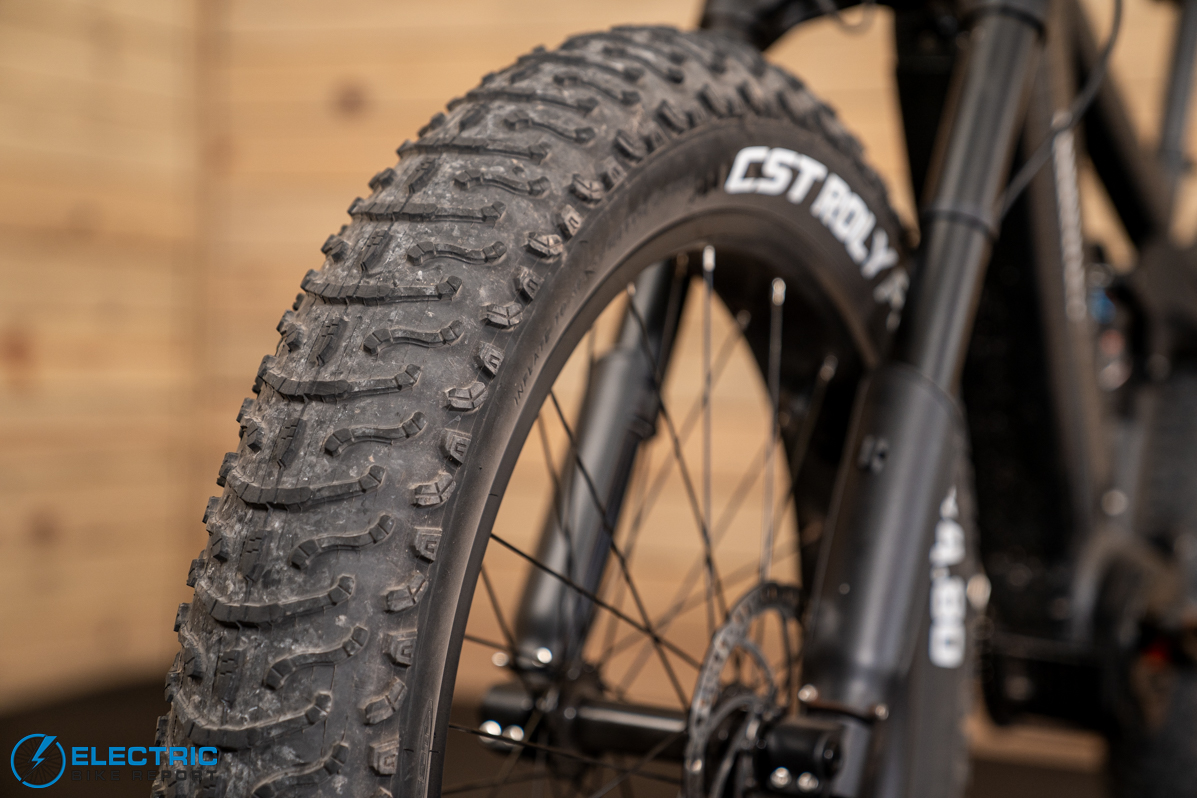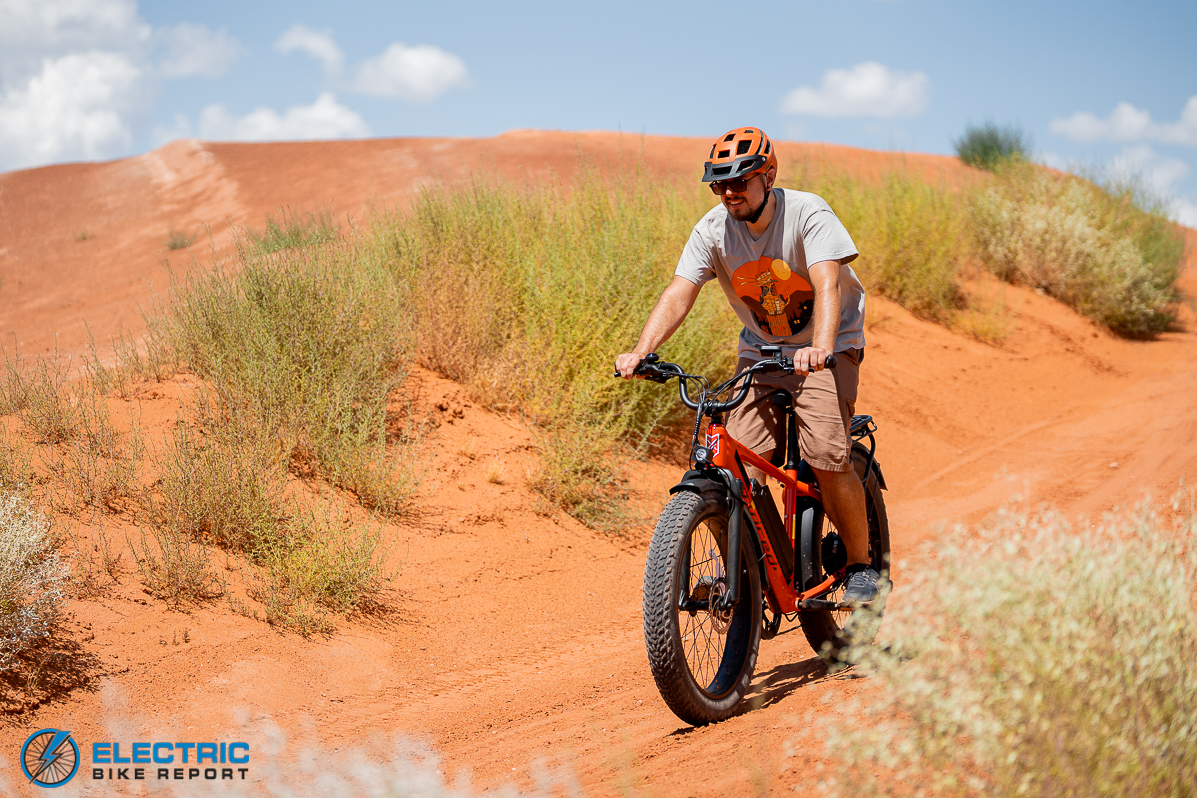Remarkably stable and confident ride
The #1 feedback we hear from people after they try a fat-tire e-bike for the first time is that they were wowed by how stable the ride was and how much confidence that gave them as they road. Feeling confident and secure is a big deal, and there may not be a more forgiving ride than that offered by a fat-tire e-bike.
There are several reasons for the stability and confidence riders feel. The first are those big wheels and tires. The heavier a wheel, the more gyroscopic effect it will generate as it spins, which will make the e-bike easier to balance. The rider won’t have to do much to keep the e-bike going straight once it is moving; in fact, a fat-tire e-bike will balance at lower speeds than any other sort of e-bike.
Those big, soft tires are less likely to be deflected if you ride over a root or rock than they are to simply roll over them, and less front wheel deflection means fewer surprises, again, adding to the rider’s confidence.
Another reason riders feel so confident on fat-tire e-bikes is that the position most riders are afforded is fairly upright, making it easier for the rider to look around and take stock of their surroundings, be they natural wonders or traffic.
Versatility
Exploring dirt roads, gravel paths and other natural-surface trails can be terrific fun, but unless that’s all you want to do, it’s handy to have an e-bike that will also allow you to make a run to the store or commute to work. Big tires roll just as well on pavement as they do on dirt, a bit faster, in fact—because a harder surface is always faster.
With a fat-tire e-bike you get a degree of flexibility in use that other e-bikes struggle to match. During the week you can ride to work and then spend the weekend exploring the wilds.
Sponsor
Unmatched comfort
Among hard-tail e-bikes, that is, e-bikes that don’t feature rear suspension, you can’t find an e-bike that offers a more comfortable ride than a fat-tire model. We don’t often discuss this, but optimal pressure for a four-in.-wide tire is less than 10 psi, and it can approach 5 psi if the tires are being run tubeless, rather than with inner tubes.
Running such low pressures makes the tires a bigger contributor to a rider’s comfort than a suspension fork. This is because a suspension fork does very little to give a rider comfort at the saddle, and how comfortable we are where we sit has a bigger effect on our overall perception of comfort than how comfortable our hands are.
Traction that can’t be beat

The combination of knobby tires and a “footprint” bigger than a toddler’s shoe means that a fat-tire e-bike enjoys traction in the dirt that can’t be matched by any other sort of tire. Traction is one of those dimensions of a rider’s experience that also influences how confident they feel when riding. And traction, unlike calcium, is something you can never get too much of.
Also helpful is how as tire pressure goes down and rider comfort goes up, so does traction, stacking two benefits in one variable.
Floats on both sand and snow
The softer the surface a rider chooses, the bigger the fat-tire e-bike’s tire footprint grows. That means that on surfaces such as sand or snow, a fat-tire e-bike “floats” on top, rather than sinking into the sand or snow, the way our feet do. This also holds true in forests where soft pine duff might make up much of the riding surface. The one place it isn’t a benefit is in mud because to gain traction in mud, you need to slice through it to the firm soil below in order to find traction.
If you live in a place with lots of sand (say near a beach or desert) or a locale with snowy winters, fat-tire e-bikes are the only way to ride.
Powerful motors

The big wheels and tires of a fat-tire e-bike require a strong, stiff frame to maintain solid control (again, a rider’s sense of control is related to their level of confidence). As a result, a fat-tire e-bike is a heavy beast, even before you add a motor and battery. To overcome their weight and give the rider a sense of easy performance, they need powerful motors. Most of the fat-tire e-bikes we test are equipped with 750W hub motors that can peak at 1000 or more watts. There are a few fat-tire e-bikes equipped with even bigger motors.
With so much muscle at your disposal, riders enjoy all the benefits of the frame’s stiffness while not being hindered by the e-bike’s weight. That’s a win-win, for sure. The powerful motor also means that they are terrific performers on hills and accelerate away from traffic lights like few other kinds of e-bike. And combine a fat-tire e-bike with a big motor and a torque sensor and you get a remarkably responsive ride.
Fewer flat tires
It’s a fact that the more a balloon is inflated and that rubber drawn tighter and tighter over a greater volume of air, the easier it is to pop. Those skinny tires on racing bikes just look for excuses to flat. By contrast, a larger tire with very little air pressure in it is difficult to puncture. Whether we’re talking a rock, nail or piece of glass, a fat tire is more likely to deform around the object than be pierced by it.
Some fat-tire e-bikes are equipped with tires and rims that are tubeless compatible. This means that the tire and tube can be removed, the rim wrapped with a special air-tight tubeless tape and then the tire can be remounted, sealant added and that further reduces the chance for a flat and even if the tire suffers a puncture, the sealant will fill the hole and prevent the tire from going completely flat. Tubeless setups also allow a rider to run even lower pressure than you can with tubes, further improving its resistance to cuts.
Weighing needs
The combination of a fat-tire e-bike’s stability and comfort combined with its difficult-to-beat versatility is often all a shopper needs to conclude that a fat-tire e-bike is the way to go, and we would have no reason to disagree. For anyone who might still be on the fence, we’re happy to point out a few more reasons why an e-bike with 4-in.-wide tires can fit your needs.
One final factor to keep in mind is that many of the fat-tire models we’ve tested, including our best performers, retail for less than $2000. Buying a fat-tire e-bike doesn’t come with a price premium; they are competitive with commuters and cruisers alike.
Sponsor
Copyright
© Electric Bike Report

